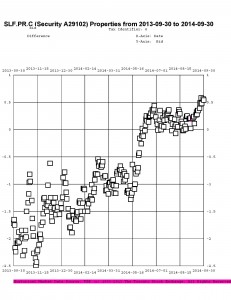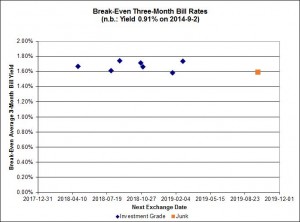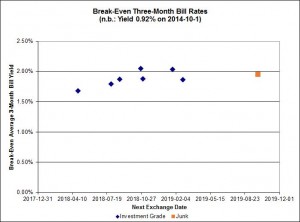Jobs, jobs, jobs!
A surprisingly powerful surge in hiring pushed unemployment to a six-year low of 5.9 percent in September as the U.S. labor market showed renewed vigor.
The 248,000 gain in payrolls followed a 180,000 increase in August that was bigger than previously estimated, the Labor Department reported in Washington. Revisions boosted the job count by 69,000 over the previous two months. The jobless rate fell from 6.1 percent to the lowest level since July 2008.
…
Another report today showed the U.S. trade deficit shrank in August to the lowest level in seven months as exports edged up to a record. The gap decreased 0.5 percent to $40.1 billion, the smallest since January, from $40.3 billion in July, the Commerce Department reported.
The narrowing deficit prompted economists at Barclays PLC in New York to boost their tracking estimate of third-quarter gross domestic product to a 3.3 percent gain at an annualized rate from 2.7 percent.
Also today, another report showed service industries grew in September to cap the strongest quarter of expansion in more than 10 years. While the Institute for Supply Management’s non-manufacturing index fell to 58.6 from the prior month’s 59.6, the third-quarter average was the highest since the first three months of 2004, the Tempe, Arizona-based group said.
The quarterly average for the group’s factory index was the highest since early 2011, a report showed earlier this week.
Meanwhile, in Canada:
Canada swung to an unexpected merchandise trade deficit in August as imports surged to a record and exports fell for the first time in four months.
The C$610 million ($543 million) deficit followed a July surplus that was pared to C$2.20 billion from the initial C$2.58 billion estimate. None of the 14 economists in a Bloomberg survey predicted that Ottawa-based Statistics Canada would report a trade deficit today, and the median estimate was for a C$1.6 billion surplus.
The report is another setback in a week that saw Statistics Canada report the world’s 11th-largest economy stalled in July after a second-quarter expansion that was led by a jump in exports. Bank of Canada Governor Stephen Poloz said last month he saw early signs of a needed rotation toward growth led by exports and business investment.
And problems in moving exportable goods don’t seem to be getting any better:
Even with a grain harvest falling below last year’s record, Western Canadian farmers can’t find enough rail cars in the right places to move their crops.
Wet, cool weather across parts of the Canadian prairies has reduced the amount of high quality grain available, helping to fuel another showdown between shippers and the nation’s largest railways. While the crop is 20 percent smaller than last year’s, it will be harder to find and move the right grades to match export sales.
Grain shippers said railways haven’t been supplying enough cars, and about 24,000 orders for transport on the prairies haven’t been filled. Canadian National Railway Co. (CNR), facing a fine for failing to meet its minimum weekly grain shipping target, said farmers haven’t been delivering enough grain to country elevators to comply with the government order.
People are borrowing for more than just houses:
If stock investors are any guide, the $1.3 trillion U.S. junk-bond market is being inflated by a growing amount of leverage being used by buyers.
Both stock and junk-bond managers tend to deploy more leverage when markets are booming, and more than ever is being used to purchase U.S. equities, based on levels of margin debt on the New York Stock Exchange, according to UBS AG (UBSN) analysts. That suggests junk-debt buyers are engaging in similar financing activities.
As investors use more borrowed cash, they increase the potential for bigger losses in a downturn. This trend adds to concern that six years of unprecedented Federal Reserve stimulus has produced a bubble in the junk-bond market — and one that will be all the more painful when it eventually pops.
…
Margin debt has surged to more than 2.5 percent of U.S. gross domestic product, about the highest level in data going back to the early 1990s, the UBS analysts [Stephen Caprio and Matthew Mish] wrote. The measure of leverage tends to be a leading indicator of relative yields on speculative-grade bonds, with a rising level of margin debt increasing the odds of future spread widening.
Investors are demanding 4.42 percentage points more than benchmark rates to own dollar-denominated high-yield bonds, compared with 5.9 percentage points on average over the past decade, Bank of America Merrill Lynch index data show.
… and Rob Carrick writes about Corporate bond ETFs: More than meets the eye:
Determined to avoid future catastrophes, the world’s regulators, central banks, investment strategists and money managers are asking questions and raising concerns about all kinds of investment trends and products. One of the latest to be scrutinized is a useful and seemingly innocuous category of exchange-traded fund that holds corporate bonds.
The concern starts with a lack of liquidity in the corporate bond market today. A liquid asset can be easily traded, without concern that you’ll have to pay a premium to acquire it or accept a discount when selling. Corporate bond liquidity has been negatively affected by a combination of a changing regulatory environment for the banks that dominate trading of these securities, and strong demand for these bonds from investors.
Today, the lack of liquidity means investors have to pay up to buy corporate bonds. When interest rates rise, it could mean they’ll take a hit if they sell. ETFs, which hold baskets of corporate bonds, complicate things. If investors dumped corporate bonds en masse, would these ETFs be able to efficiently sell their holdings as needed?
He then spoils this excellent question by allowing disingenuous salesmen to slip off the hook really easily:
If you did submit a sell order for your corporate bond ETF, it would be matched with a buy order from another investor. Even if corporate bonds turn toxic, there are investment dealers designated to maintain an orderly market in ETF trading. They’re supposed to put in a bid for the ETF units you’re selling, even if the price would reflect prevailing market conditions.
These dealers would have the option of exchanging the ETF units they’ve accumulated for the underlying securities. At BlackRock Canada, they say that’s not a problem. “You can’t make an ETF if you don’t have liquid underlying [investments],” said Noel Archard, the company’s head and managing director.
Alfred Lee, vice-president and portfolio manager at BMO Mutual Funds, said corporate bond ETFs give investors more liquidity than if they tried to sell an individual bond. “Given a liquidity event, liquidity is not going to be as good as in a normal environment. But we’re going to be owning the most liquid bonds out there.”
To sum up, problems in the corporate bond market will be reflected in the price of bond ETFs. However, ETF industry people say their funds will not exacerbate things.
(The article is also spoilt by the inclusion of the old nonsense about how risk and return are magically changed by putting the raw materials into a box.[ETF] Disadvantages: No maturity date, which means prices subject to interest rate trends. See Bond ETFs demystified for an explanation of what is really going on.)
Anyway, I hope that Noel Archard was misquoted, or quoted out of context, or severely shortened, or something, because his statement is nonsense. Synthetic ETFs can be a threat to financial stability; I’ll agree that there aren’t many of these in Canada, but we do have some, we could have more, and the underlying investments can be illiquid.
Alfred Lee also evades the question, by claiming that his firm (? Does this mean BMO ETFs? BMO Mutual Funds? BMO as principal?) will ‘be owning the most liquid bonds out there’. Who cares, in a crisis (and, I might ask, does he have a mandate to focus on liquidity?)? The issue is the price sensitivity of these bonds.
There are three main problems that I see:
- Firstly, in a crisis, people are going to want to get out faster than they got in; i.e., we could see one month’s redemptions equal to X month’s current purchases. This will pressure dealer inventories and hence prices.
- Secondly, we can expect risk aversion to increase in a crisis, which will increase the price sensitivity to this picked up selling, and
- Thirdly, there is the structural issue … ETFs are meant to increase the liquidity of an investment in their underlying. That’s their whole point! The implication is that you have investors in a particular asset class (e.g., the corporate bonds currently being discussed) whose holdings would be reduced, or non-existent, if they had to invest directly in the underlying (i.e., the liquidity provided by the ETF is a critical contributor to their decision to invest in the asset class). Therefore, on top of the increase in risk aversion due to the crisis, you’ve also got a structural increase in risk aversion.
It could be ugly, by which I mean a beautiful time to be trading.
There’s a strange story on US employment law:
On Oct. 8 the Supreme Court will hear arguments about whether that time counts as work. In 2010 two former employees of Integrity Staffing Solutions, a temp agency that supplies workers at many of Amazon’s U.S. warehouses, sued the company demanding back pay for the time they spent in security lines after clocking out at Amazon warehouses in Nevada. The security checks, the plaintiffs argued, were required by Integrity and therefore part of the job. (Amazon-employed workers go through the same checks.)
At issue is the scope of a 1947 amendment to the Fair Labor Standards Act that says employers don’t have to pay for time spent on work-related activities like getting to or from the office. Nine years later, the Supreme Court established in a pair of rulings that the key is whether the activity in question is “integral and indispensable” to the principal activities workers are paid to do. Butchers at a meatpacking plant, the court found, had to be paid for time spent sharpening their knives, and workers at a battery plant deserved compensation for time spent showering after work to wash off traces of sulfuric acid and lead.
The question in the Integrity case is whether security checks are more like those showers or more like commuting. With screenings increasingly common, the case could have implications for a wide range of workplaces….
Integrity says it doesn’t owe the workers money because the screenings weren’t directly related to their jobs. “No court has ever held that ‘not breaking the law’ is a principal job activity for which compensation must be paid,” the company’s lawyers wrote in a brief last May.
To me, this is open and shut. Of course time spent going through a security check should be compensated, if the employer insists you do it. I can reduce my commute by living in a tent at the warehouse’s front door, but reducing the time spent proving I’m not a crook is beyond my power (unless I quit my job, which I would). But not only has this case made it to the Supreme Court, but the Comrade Peace Prize administration is supporting the employers!
The Departments of Justice and Labor also submitted on Integrity’s behalf. There is, Solicitor General Donald Verrilli Jr. wrote, “no clear-cut distinction—either in terms of purpose or effect—between petitioner’s screenings and those that are routine at countless government and private-sector buildings.”
Crazy world. The forces of fear have won.
As an aside, I went to hotair.com to see what this week’s official Republican talking points on the issue are, but couldn’t find a mention of the SCOTUS Integrity case. I did find this complaint about a subtraction algorithm in the Common Core, though; as I often am when reading HotAir, I was perplexed by the level of annoyance shown. I use this algorithm all the time when doing mental subtraction. What’s the big deal?
It was a mixed day for the Canadian preferred share market, with PerpetualDiscounts gaining 5bp, FixedResets off 1bp and DeemedRetractibles down 4bp. Volatility was minimal. Volume was low.
HIMIPref™ Preferred Indices
These values reflect the December 2008 revision of the HIMIPref™ Indices
Values are provisional and are finalized monthly |
| Index |
Mean
Current
Yield
(at bid) |
Median
YTW |
Median
Average
Trading
Value |
Median
Mod Dur
(YTW) |
Issues |
Day’s Perf. |
Index Value |
| Ratchet |
3.12 % |
3.11 % |
24,215 |
19.46 |
1 |
-0.6617 % |
2,673.7 |
| FixedFloater |
0.00 % |
0.00 % |
0 |
0.00 |
0 |
0.0413 % |
4,123.4 |
| Floater |
2.89 % |
3.04 % |
59,780 |
19.67 |
4 |
0.0413 % |
2,768.7 |
| OpRet |
4.05 % |
2.58 % |
108,040 |
0.08 |
1 |
0.0000 % |
2,729.3 |
| SplitShare |
4.30 % |
4.03 % |
93,948 |
3.87 |
5 |
-0.2147 % |
3,145.5 |
| Interest-Bearing |
0.00 % |
0.00 % |
0 |
0.00 |
0 |
0.0000 % |
2,495.6 |
| Perpetual-Premium |
5.47 % |
1.62 % |
74,462 |
0.08 |
18 |
0.0393 % |
2,446.7 |
| Perpetual-Discount |
5.33 % |
5.18 % |
97,840 |
15.11 |
18 |
0.0455 % |
2,584.4 |
| FixedReset |
4.21 % |
3.75 % |
176,558 |
8.53 |
73 |
-0.0112 % |
2,553.9 |
| Deemed-Retractible |
5.01 % |
2.48 % |
102,022 |
0.39 |
42 |
-0.0437 % |
2,561.9 |
| FloatingReset |
2.56 % |
-6.56 % |
64,696 |
0.09 |
6 |
0.4549 % |
2,552.5 |
| Performance Highlights |
| Issue |
Index |
Change |
Notes |
| MFC.PR.F |
FixedReset |
1.59 % |
YTW SCENARIO
Maturity Type : Hard Maturity
Maturity Date : 2025-01-31
Maturity Price : 25.00
Evaluated at bid price : 22.41
Bid-YTW : 4.54 % |
| Volume Highlights |
| Issue |
Index |
Shares
Traded |
Notes |
| IFC.PR.C |
FixedReset |
73,270 |
RBC crossed 70,000 at 25.54.
YTW SCENARIO
Maturity Type : Call
Maturity Date : 2016-09-30
Maturity Price : 25.00
Evaluated at bid price : 25.50
Bid-YTW : 3.19 % |
| BNS.PR.Z |
FixedReset |
69,827 |
National bought blocks of 10,000 shares, 25,000 and 10,700 from TD, all at 24.55.
YTW SCENARIO
Maturity Type : Hard Maturity
Maturity Date : 2022-01-31
Maturity Price : 25.00
Evaluated at bid price : 24.26
Bid-YTW : 3.52 % |
| RY.PR.H |
FixedReset |
67,800 |
Scotia crossed 60,000 at 25.33.
YTW SCENARIO
Maturity Type : Call
Maturity Date : 2019-08-24
Maturity Price : 25.00
Evaluated at bid price : 25.33
Bid-YTW : 3.72 % |
| TRP.PR.A |
FixedReset |
63,600 |
TD crossed 25,000 at 22.45.
YTW SCENARIO
Maturity Type : Limit Maturity
Maturity Date : 2044-10-03
Maturity Price : 21.91
Evaluated at bid price : 22.42
Bid-YTW : 3.93 % |
| TRP.PR.E |
FixedReset |
53,200 |
TD crossed 50,000 at 25.02.
YTW SCENARIO
Maturity Type : Limit Maturity
Maturity Date : 2044-10-03
Maturity Price : 23.16
Evaluated at bid price : 25.01
Bid-YTW : 3.90 % |
| ENB.PF.C |
FixedReset |
35,321 |
RBC crossed 25,000 at 25.12.
YTW SCENARIO
Maturity Type : Limit Maturity
Maturity Date : 2044-10-03
Maturity Price : 23.17
Evaluated at bid price : 25.11
Bid-YTW : 4.19 % |
| There were 22 other index-included issues trading in excess of 10,000 shares. |
| Wide Spread Highlights |
| Issue |
Index |
Quote Data and Yield Notes |
| BNS.PR.A |
FloatingReset |
Quote: 25.80 – 26.32
Spot Rate : 0.5200
Average : 0.3172
YTW SCENARIO
Maturity Type : Call
Maturity Date : 2014-11-02
Maturity Price : 25.50
Evaluated at bid price : 25.80
Bid-YTW : -13.74 % |
| MFC.PR.F |
FixedReset |
Quote: 22.41 – 23.00
Spot Rate : 0.5900
Average : 0.4035
YTW SCENARIO
Maturity Type : Hard Maturity
Maturity Date : 2025-01-31
Maturity Price : 25.00
Evaluated at bid price : 22.41
Bid-YTW : 4.54 % |
| RY.PR.L |
FixedReset |
Quote: 26.26 – 26.56
Spot Rate : 0.3000
Average : 0.1810
YTW SCENARIO
Maturity Type : Call
Maturity Date : 2019-02-24
Maturity Price : 25.00
Evaluated at bid price : 26.26
Bid-YTW : 3.15 % |
| IAG.PR.G |
FixedReset |
Quote: 26.05 – 26.33
Spot Rate : 0.2800
Average : 0.1728
YTW SCENARIO
Maturity Type : Call
Maturity Date : 2017-06-30
Maturity Price : 25.00
Evaluated at bid price : 26.05
Bid-YTW : 2.73 % |
| GWO.PR.I |
Deemed-Retractible |
Quote: 22.35 – 22.72
Spot Rate : 0.3700
Average : 0.2778
YTW SCENARIO
Maturity Type : Hard Maturity
Maturity Date : 2025-01-31
Maturity Price : 25.00
Evaluated at bid price : 22.35
Bid-YTW : 5.92 % |
| CGI.PR.D |
SplitShare |
Quote: 25.04 – 25.34
Spot Rate : 0.3000
Average : 0.2093
YTW SCENARIO
Maturity Type : Soft Maturity
Maturity Date : 2023-06-14
Maturity Price : 25.00
Evaluated at bid price : 25.04
Bid-YTW : 3.77 % |




